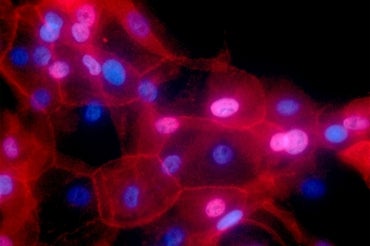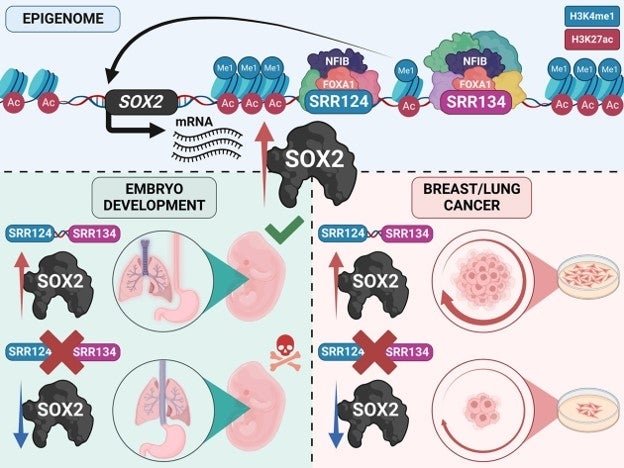Certain cancers can activate 'enhancer' in the genome to drive tumour cell growth: Study

(Photo by Ewa Krawczyk, National Cancer Institute \ Georgetown Lombardi Comprehensive Cancer Center, National Institutes of Health)
Published: October 16, 2023
Researchers at the University of Toronto have found that cancer cells can enhance tumour growth by hijacking enhancer DNA normally used when tissues and organs are formed.
The mechanism, called “enhancer reprogramming,” occurs in bladder, uterine, breast and lung cancer – and could cause these types of tumors to grow faster in patients.

The research was conducted in the lab of Jennifer Mitchell, a professor in the department of cell and systems biology in the Faculty of Arts & Science, and published recently in the journal Nucleic Acids Research. It pinpoints the role that specific proteins play in regulating the enhancer region which may lead to improved treatments for these cancer types.
Living cells, even cancer cells, follow instructions in the genome to turn genes on and off in different contexts, says first author Luis Abatti, a PhD candidate in Mitchell’s lab.
“The genome is like a recipe book written in DNA that gives instructions on making all the parts of the body,” Abatti says.
“In each organ, only the recipes relevant to that organ should be followed – whether it’s the instructions for lung, breast or some other tissue. Like flipping pages in a recipe book, the DNA containing the instructions for turning genes on in the lung is open and used in the lung, for example, but closed and ignored in other types of cells.

“We know that some cancer cells are opening the wrong pages in the recipe book – ones that contain the SOX2 gene, which can cause tumours to grow uncontrollably. We wanted to find out: How does the gene become expressed in cancer cells?”
The researchers analyzed genome data to look for enhancer DNA that could activate SOX2 in cancer cells. The enhancer they found is open in many different types of patient tumours, meaning this could be a cancer enhancer active in bladder, uterus, breast and lung tumours. Unlike many cancer-causing changes, the enhancer reprogramming mechanism does not arise out of mutation due to DNA damage – it is caused by part of the genome opening when it should be staying closed.
The researchers then determined that the enhancer causes increased cancer cell growth because when they removed the enhancer in lab-grown cells, the cancer cells created fewer new tumour colonies.
To figure out why cells have a DNA region that makes cancer worse, the team examined mice without this DNA region and found they do not form a separate passage for air and food in their throat as they develop. Thus, this potentially dangerous cancer-enhancer region is likely in the human genome to regulate airway formation as the human body forms. However, if a developing cancer cell opens this region, it will form a tumour that grows faster and is more dangerous for the patient.

“We also found that two proteins known to have a role in the developing airways – FOXA1 and NFIB – are now regulating SOX2 in breast cancer,” says Mitchell, who is associate chair of research in the department of cell and systems biology and is cross-appointed to the department of laboratory medicine and pathobiology in the Temerty Faculty of Medicine.
The enhancer is activated by the FOXA1 protein and suppressed by the NFIB protein. This means that drugs suppressing FOXA1 or activating NFIB may lead to improved treatments for bladder, uterine, breast and lung cancer.
“Now that we know how the SOX2 gene is activated in certain types of cancers, we can look at why this is happening,” Mitchell says.
“Why did the cancer cells end up on the wrong page of the genome recipe book?”
The research received support from the Canadian Institutes of Health Research, the Canada Foundation for Innovation and the Ontario government.



